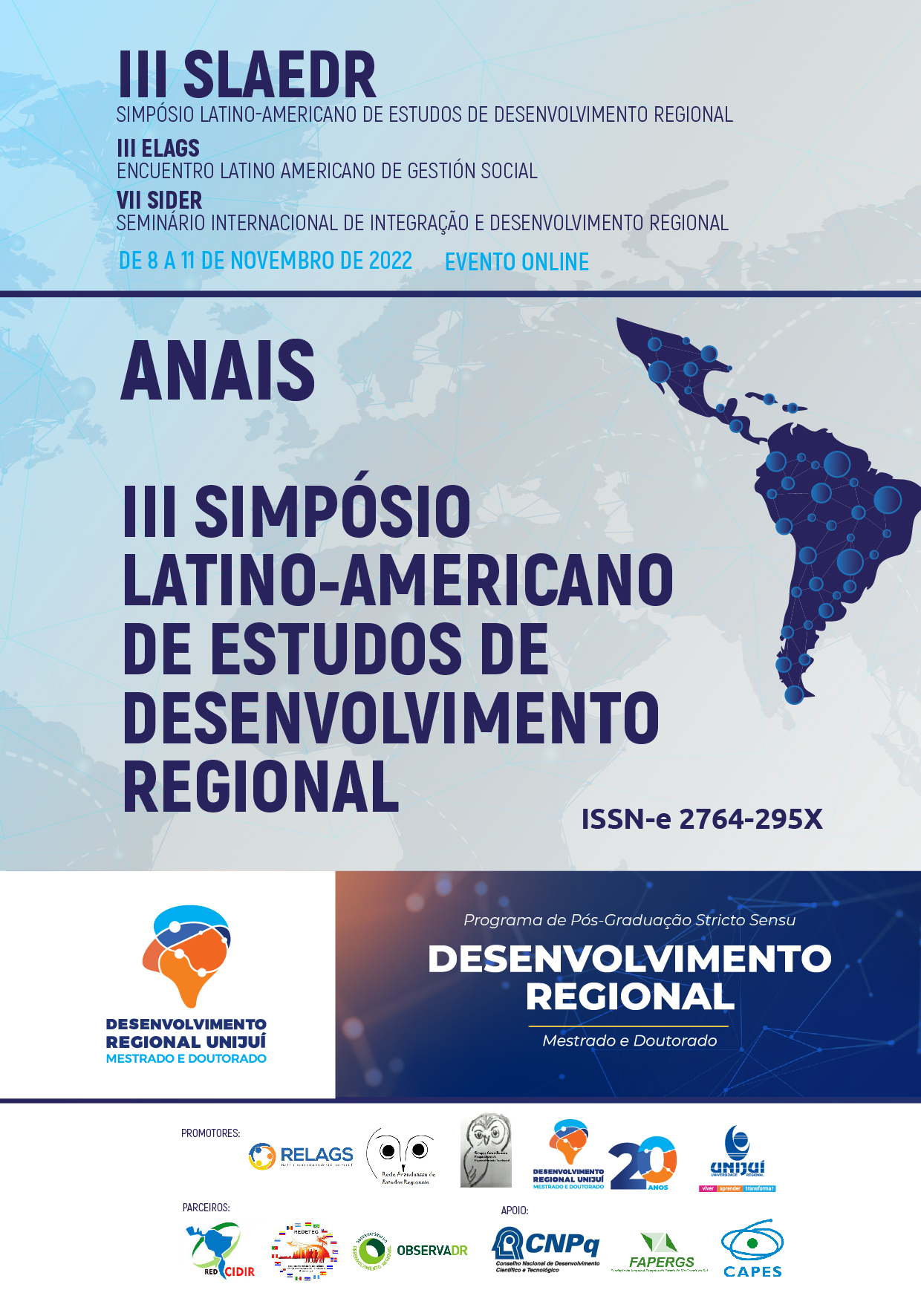COMÉRCIO INTERNACIONAL DOS MUNICÍPIOS DE GOIÁS:
UMA APLICAÇÃO DO MODELO GRAVITACIONAL
Palavras-chave:
Goiás, Municípios, Modelo Gravitacional, Comércio InternacionalResumo
Este estudo pretende analisar os determinantes do comércio internacional dos municípios que fazem parte do estado de Goiás a partir do modelo econométrico gravitacional. Os modelos foram estimados por Mínimos Quadrados Ordinários com dados do comércio exterior de Goiás a nível municipal para o ano de 2018. Estimaram-se duas regressões com o fluxo comercial dos municípios em função da população, do Produto Interno Bruto e da distância, e foi realizado um ranking com os países que mais exportam e importam com o estado. A China foi o principal país que realizou comércio com os municípios goianos nesse período e grande parte desse comércio decorrente das exportações de produtos agropecuários. Os resultados confirmam que o fluxo comercial entre os municípios goianos e os 47 países da amostra são determinados pelos fatores de atração, como a população dos países e dos municípios, porém, não são determinados pelos fatores de resistência, como a distância.
Referências
AITKEN, N. D. The effect of the EEC and EFTA on European trade: a temporal cross-section analysis. The American Economic Review, Tennessee, v. 63, n. 5, p. 881-892, 1973.
ARRIEL, M. F. Perfil Produtivo e Dinâmica Espacial da Indústria Goiana – (1999-2007). 2010. Dissertação (Mestrado em Desenvolvimento e Planejamento Territorial) – Departamento de Ciências Econômicas, Pontifícia Universidade Católica de Goiás, Goiânia, 2010.
BALASSA, B. Exports and economic growth: further evidence. Journal of Development Economics, Washington, v.5, n.2, p. 181-189, 1978.
CASSANO, F. A. A teoria econômica e o comércio internacional. Pesquisa & Debate. Revista do Programa de Estudos Pós-Graduados em Economia Política, São Paulo, v. 13, n. 1, p. 112-128, 2002.
CHENG, I.; WALL, H. J. Controlling for heterogeneity in gravity models of trade and integration. Federal Reserve Bank of St. Louis Review, St. Louis, v. 87, n. 1, p. 49-63, 2005.
FARIAS, J. J.; HIDALGO, Á. B. Comércio interestadual e comércio internacional das regiões brasileiras: uma análise utilizando o modelo gravitacional. Revista Econômica do Nordeste, Fortaleza, v. 43, n. 2, p. 252-265, 2012.
FEDER, G. On exports and economic growth. Journal of Development Economics, Amsterdam, v. 12, p. 59-73, 1982.
FILHO, J. E. H. Uma análise da atividade comercial entre o município de São Gonçalo Do Amarante e os demais municípios cearenses: uma aplicação do modelo gravitacional. 2017. Dissertação (Mestrado em Economia) – Programa de Pós-Graduação em Economia, Universidade Federal do Ceará, Fortaleza, 2017.
GOIÁS. Secretaria de Estado de Gestão e Planejamento. Instituto Mauro Borges. Balança Comercial Goiana – Comex. 2019. (Análises Conjuturais). Disponível em: w.imb.go.gov.br/files/docs/releases/comex/2018/comex201812.pdf. Acesso em: 20 set. 2021.
GRAF, C. O.; AZEVEDO, A. F. Z. Comércio bilateral entre os países membros do Mercosul: uma visão do bloco através do modelo gravitacional. Economia Aplicada, Ribeirão Preto, v. 17, n. 01, p. 135-158, 2013.
HIDALGO, Á. B.; VERGOLINO, J. R. O Nordeste e o comércio inter-regional e internacional: um teste dos impactos por meio do modelo gravitacional. Revista Economia Aplicada, Ribeirão Preto, v.2, n.4, p. 707-725, 1998.
INSTITUTO MAURO BORGES. Goiás: exportações, importações, suas origens e destinos. Goiânia, 2014. Disponível em: https://www.imb.go.gov.br/files/docs/publicacoes/estudos/ 2014/goias-exportacoes-importacoes-origens-destinos.pdf. Acesso em: 01 nov. 2020.
LEUSIN, S.; AZEVEDO, A. O efeito fronteira das regiões brasileiras: uma aplicação do modelo gravitacional. Revista Economia Contemporânea, Rio de Janeiro, v. 13, n. 2, p. 229-258, 2009.
LUCENA, A. F.; CAMPOS, F. R.; SANTOS, J. F. Exportações e desenvolvimento econômico regional em Goiás. Revista Brasileira de Desenvolvimento Regional, Blumenau, v. 9, n. 2, p. 189-210, 2021.
LUCENA, A, F.; SILVA, F. T.; VIEIRA, E. R. Efeito-fronteira em Goiás: uma análise de seus impactos no comércio intranacional e internacional. Redes (St. Cruz Sul, Online), Santa Cruz do Sul, v. 25, p. 2549-2567, 2020.
MCCALLUM, J. National borders matter: Canada-U.S. Regional trade patterns. The American Economic Review, Pittsburgh, v. 85, n. 3, p. 615-623, 1995.
MAGALHÃES, A. S.; DOMINGUES, E. P. Relações interestaduais e intersetoriais de comércio no Brasil: uma análise gravitacional e regional. Revista Brasileira de Estudos Regionais e Urbanos, Curitiba, v.2, n.1, p. 76-102, 2008.
MENDES, K.; HIDALGO, Á. B.; LUCHINE, A. A. O comércio internacional dos municípios brasileiros entre 2000 e 2010: uma aplicação do modelo gravitacional. In: ENCONTRO NACIONAL DE ECONOMIA, 48., 2020, Niterói. Anais Eletrônicos [...]. Rio de Janeiro: UFF, 2020. p.1-19. Disponível em: https://www.anpec.org.br/encontro/2020/submissao/files_I/i7-7efe57ca2df7aab56cff7bf 95bc43a3f.pdf. Acesso em: 29 out. 2020.
MATYAS, L. Proper econometric specification of the gravity model. The World Economy, Oxford, v. 20, n. 3, p. 363-368, 1997.
MOREIRA, U. Teorias do comércio internacional: um debate sobre a relação entre crescimento econômico e inserção externa. Revista de economia Política, São Paulo, v. 32, n. 2, p. 213-228, 2012.
NASCIMENTO, F.; JÚNIOR, D. P. A evolução do modelo gravitacional na economia. Revista Saber Humano, Recanto Maestro-RS, v. 2, n. 3, p. 163-175, 2013.
NORTH, D. Teoria da localização e crescimento econômico regional. In: SCWARTZMAN, J. (org.) Economia Regional. Textos escolhidos. Belo Horizonte: Cedeplar, 1977. p. 291-313.
PIANI, G.; KUME, H. Fluxos bilaterais de comércio e blocos regionais: uma aplicação do modelo gravitacional. Rio de Janeiro: IPEA, 2000. (Texto para discussão, n. 749).
POLAK, J. J. Is APEC a natural regional trading bloc? A critique of the “Gravity Model” of international trade. The World Economy, Oxford, v. 19, n. 5, p. 533-543, 1996.
SÁ PORTO, P. C. Porto, Blocos de Comércio e Desenvolvimento Regional no Brasil. Leopoldianum: Revista de estudos e comunicações da Universidade Católica de Santos, v.96, n. 98, p. 1-25, 2010.
VENABLES, A. J.; LIMÃO, N. Geographical disadvantage: a Heckscher-Ohlin-von Thunen model of international specialization. Journal of Internacional Economics, [The Netherlands], v. 58, n. 2, p. 239-263, 2002.
WANG, Z.; WINTERS, L. A. The trading potential of Eastern Europe. Journal of Economic Integration, Seoul, v. 7, n. 2, p. 113-136, 1992.



